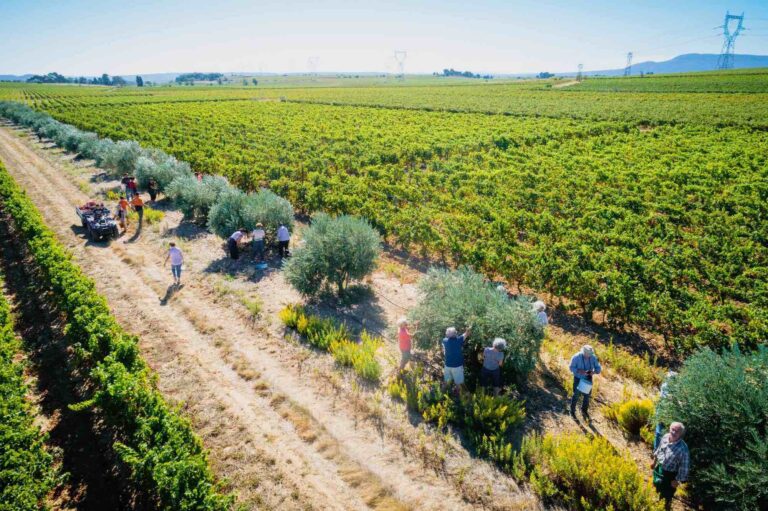

La Stoppa in the Colli Piacentini
- A snapshot of the La Stoppa vineyard and property
- A note on the 2017 climate – dry with reasonable heat
- Description of the terroir and current issues
- Tasting notes on wines available today

Tasting: Azienda Vitivinicola La Stoppa
July 18, 2017
Going back to La Stoppa is always a breath of fresh air, I remember it as if it were yesterday. Angela Pantaleoni – Mother of Elena, the current owner and friend – had come to pick me up at the station of Piacenza to take me to the field. After a 20 minute drive, we took a path on the left, leaving the main road towards Bobbio.
Turn after turn, the trail climbed very steeply up the hill. I marveled at the landscape; this little wood that we crossed, then the first planted vines and finally, the field at the end of the road with its medieval tower, standing majestic and serene as if she were watching over the hill.
Here, as in Denavolo, the winter of 2017 was dry and not very rigorous. The spring did not bring much rain either, and so it is also a dry vintage. Early bud burst was halted very quickly because of temperature cooling at the end of April. Luckily there are no worries of freezing or hail in the field. We will keep our fingers crossed in hopes that the summer continues like this: hot temperatures without excessive weather patterns.
The soil is a vibrant, iron-coloured red clay. Silty, it is a deep and dusty soil littered with burnt-red clay stones. The clays plays an important role as sponge to ensure the vines are fed with water until the grapes are harvested, which allows them to reach complete phenolic maturity.


The estate is composed of 32 ha of vines mostly all around the domain with some on an opposite slope and 18 ha of wood. The vines are now the indigenous Barbera, Bonarda, Ortugo, Trebiano and Malvasia di Candia Aromatica. Some vines of Merlot (very old vines), Grenache and Semillon co-exist.
In recent years, the pressure of Flavescence dorée has become an important issue to take seriously. Flavescence dorée results in vines with red foliage. The disease is linked to a phytoplasma (a bacterium lacking cellular parietes) transported by leafhopper. When the leaves are red, photosynthesis cannot occur, and the grapes can’t ripen. There are two solutions for this disease – replacing and replanting the vine, or treatment with arsenic. La Stoppa practices only organic culture in the vineyard, so replanting is the only solution.
Fortunately not all the vineyards are affected, especially the vines planted after 2004. Why? After 2004, a law was implemented by the government that no longer allows massal selection from the vines inside the estate, only from vines outside of the estate that have been deemed safe and disease free. This law was enacted to avoid having sick vines and spreading the disease. In the photo below, we can see the start of véraison for the Barbera, a few days ahead of usual.


Tasting Notes of Current Wine Available:
2015 Trebbiolo – IGT Emilia Rosso – warm vintage
(50% Bonarda, 50% Barbera)
Younger vines. Fermentation and elevage in concrete and stainless tanks. Juicy raspberries, sour red cherries, very intense nose of cassis, and fresh mouth-watering acidity. The palate is rich with iron, with a slight brush of Italian lavender. This is the third bottling and release of the 2015 Trebbiolo.
2009 Barbera – warm vintage
The nose presents spicy notes of cinnamon bark, dried cedar trees, red cherry, black licorice, red plums. The palate is more animalistic – bloody, iron, and raw tartare. A product of long maceration and aging. Despite the warm vintage, the wine presents a crisp and searing malic acidity.
2006 Barbera – classic vintage, less warm than 2009
A savoury nose of Italian salumi and Mortadella. Dried potpourri, espresso, cacao nibs and powdered chocolate. This brooding wine finishes with well-integrated tannins and an underlying balsamic finish. Aged in bottle for 2 years.
2002 Macchiona – fresh and humid vintage
(Old Vine Barbera 50% and Bonarda 50%)
Perfumed bouquet of herbs – thyme, rosemary – raisins, red cherry, blackberry, beetroot, potpourri. A well-structured expression of the Macchiona. Though a difficult vintage with much sorting and selection (less than 50% of normal vintage), the wine has benefitted from long bottle aging and is now singing from the glass.
2006 Macchiona
(Old Vine Barbera 50% and Bonarda 50%)
A nose brimming with umami, animal underbrush, and savoury aromas. The palate is clean and fresh, with a mouth full of berry yogurt and dried cherries. The juicy fresh acidity is thirst-quenching and explosive on the tongue. A country gentleman wearing a suit with a silk tie. Classic.
2009 Macchiona – warm vintage
(Old Vine Barbera 50% and Bonarda 50%)
Pure fruit-forward expression of Macchiona with fresh strawberries and red cherries. Powerful tannins are a product of the warm vintage, perfumed violets, and a wild bloody finish full of iron.
2011 Macchiona – warm vintage (warmer than 2009)
(Old Vine Barbera 50% and Bonarda 50%)
Newly bottled in the Burgundy bottle, which is replacing the Bordeaux bottle. Fruity, Morello cherries, riper mouth, chocolate, and juicy raspberries. Ripe vintage.
2012 Ageno
(Malvasia di Candidia Aromatica, Trebbiano, Ortrugo)
Fresh, bright and clean wine with herbal rosemary notes. Spicy and viscous palate, a touch of savoury mortadella, orange pith, resin, pine sap. Zingy citrus acidity, white grapefruit, cedar, and fresh oranges with a nice tart mouth.


